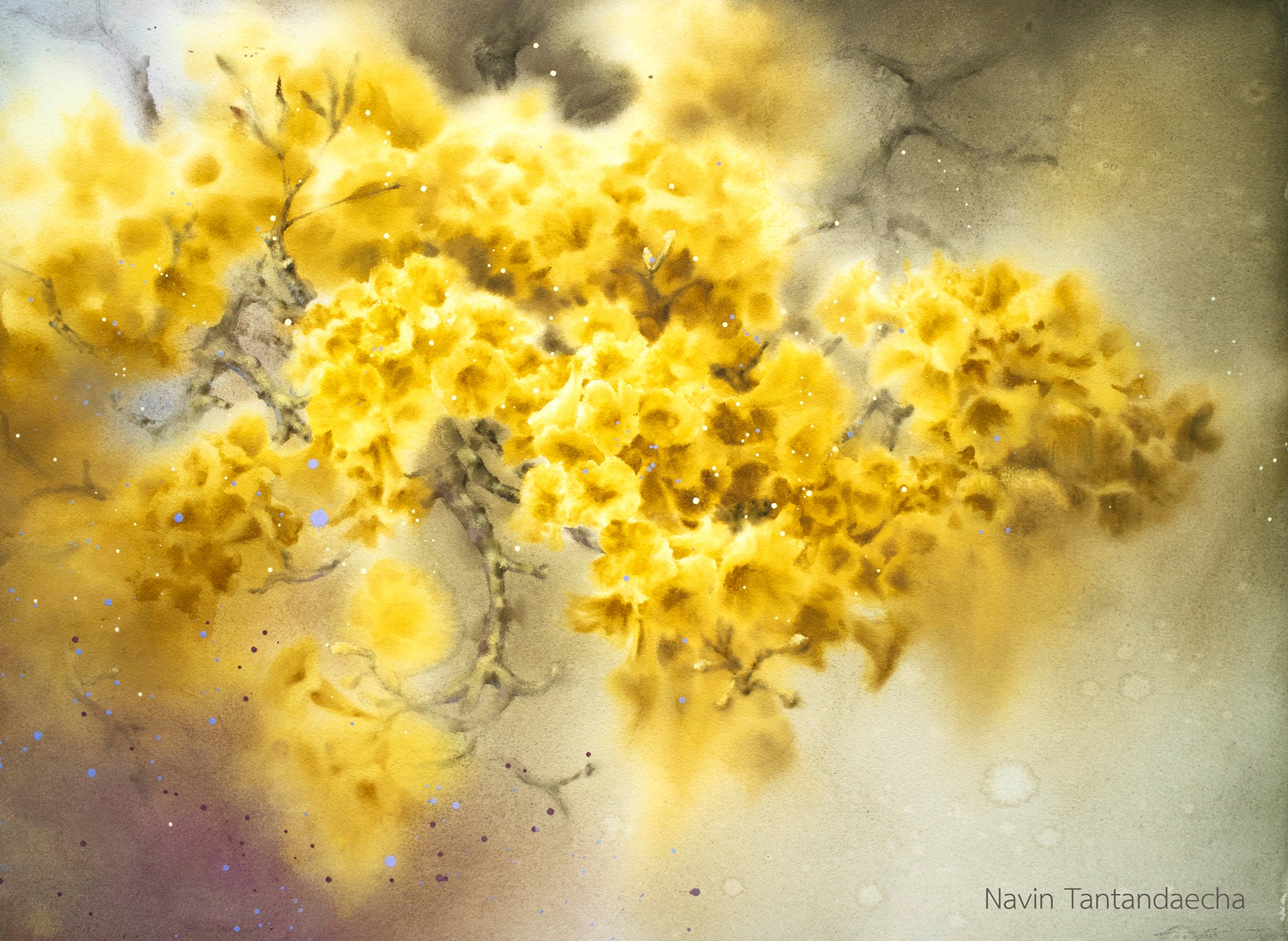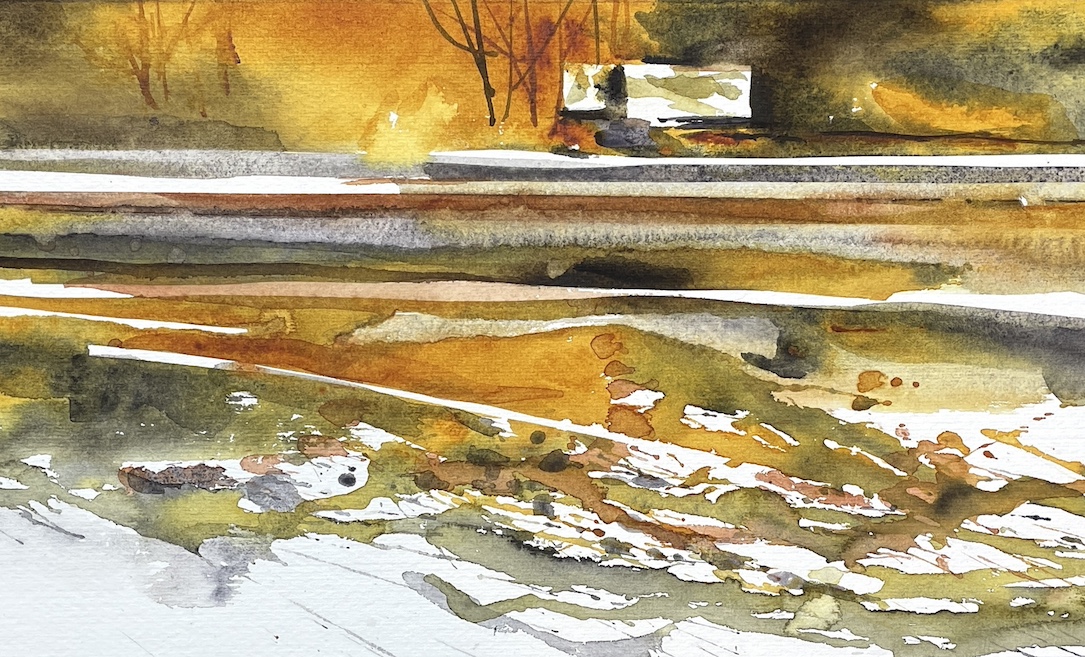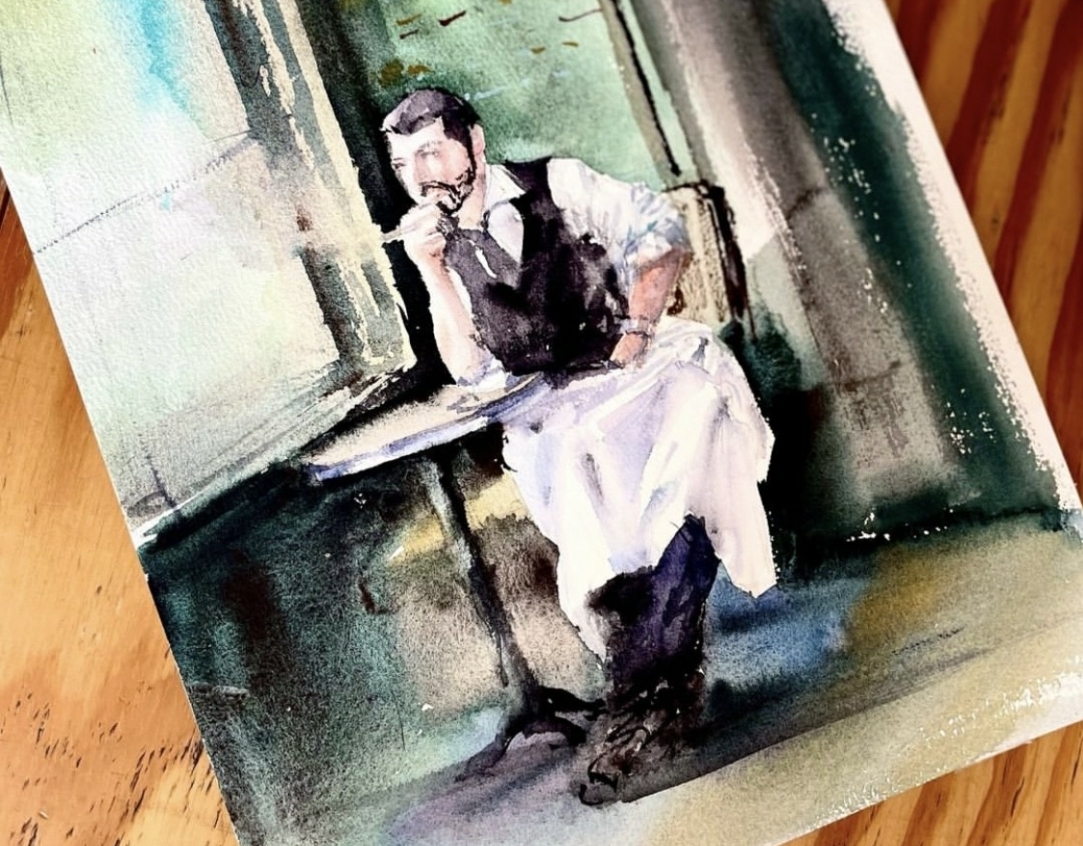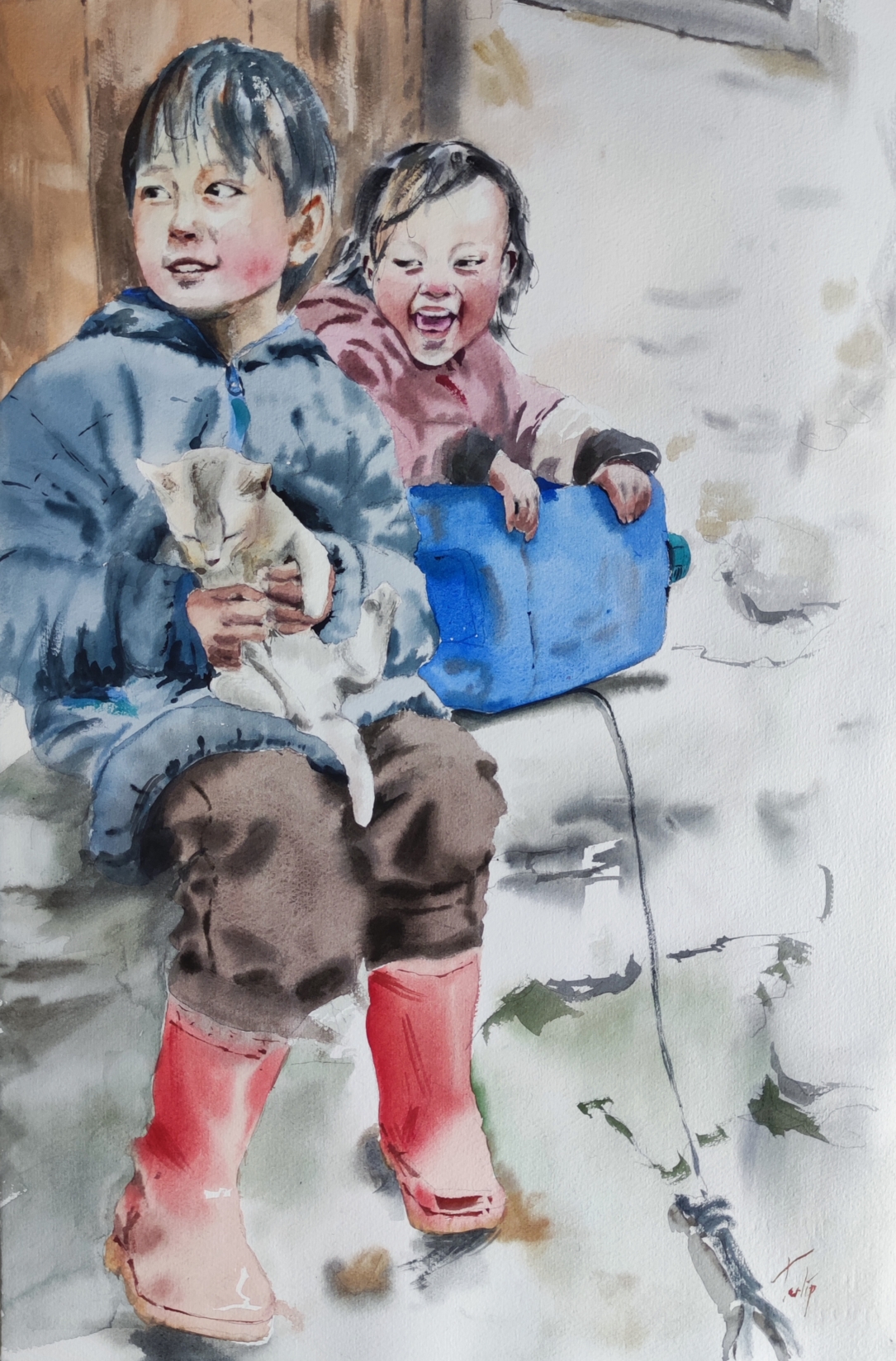Voici une séance de questions-réponses avec Navin Tantanadaecha
Pourquoi fais-tu de l'art ?
En tant qu'être humain, je suis passionné par l'exploration de l'épanouissement personnel. L'art m'offre un espace où je peux observer méditativement le processus de développement intérieur et extérieur. Grâce à mon expérience d'éducateur et d'artiste, j'ai compris que l'art est un langage universel et un moyen d'expression illimité. De plus, l'art est toujours sincère et reflète qui nous sommes vraiment ; c'est une forme de communion.
L'aquarelle a toujours reflété mon état d'esprit à chaque étape de ma vie grâce à ses qualités – douceur, fluidité, incertitude, transparence, entre autres – me permettant de me connecter à ma véritable voix et de l'exprimer. Pour moi, l'aquarelle est un lieu essentiel pour étudier l'évolution de la vie.
Depuis combien de temps peignez-vous ?
J'ai environ 16 ans d'expérience avec l'aquarelle. En 2009, je l'ai découverte comme matière obligatoire à l'université, mais je n'en ai pas eu une bonne impression, car j'avais du mal à maîtriser ce médium. J'ai donc décidé d'explorer d'autres techniques. Trois ans plus tard, lors de mon dernier semestre, j'ai rencontré Siriratana Sriseung, qui est devenue ma plus grande inspiration pour l'aquarelle. Elle m'a appris à accepter son incertitude, ce qui m'a fait passer d'une simple tentative de contrôle à une acceptation et une utilisation plus concrètes. Ce fut également le début de ma carrière professionnelle.
Avez-vous suivi une formation artistique formelle?
Oui. Ma formation artistique formelle peut se diviser en deux périodes. La première s'est concentrée sur le développement de mes compétences de base en dessin et en peinture grâce à un tutorat en maison de retraite, afin de me préparer à intégrer une université d'art. Plus tard, pendant mes études universitaires en éducation artistique, j'ai élargi mes horizons à la gravure, à la peinture, à la sculpture et au design, bases essentielles de l'enseignement artistique.
Êtes-vous un artiste travaillant ou un amateur?
Je suis actuellement artiste-enseignante professionnelle. Cependant, j'ai commencé comme amateur, cherchant à capturer la beauté des fleurs au cœur de la jungle urbaine de Bangkok. Au fil du temps, mon récit s'est élargi à l'art abstrait, à travers lequel j'explore le sens de l'art et de la vie.
La transition du statut d'amateur à celui d'artiste professionnel s'est faite progressivement. Ma pratique régulière et mes expositions se sont développées naturellement au fil du temps.
Qui et/ou quoi cherchez-vous pour vous inspirer ?
De nombreux artistes m'ont inspiré à chaque étape de ma carrière. Au début, Siriratana Sriseung m'a appris que l'incertitude est l'essence même de l'aquarelle, ce qui m'a permis de passer du contrôle du médium à l'acceptation de son imprévisibilité. Un autre artiste influent était Adisorn Pornsirikarn, qui m'a aidé à apprécier la fraîcheur et la fluidité de l'aquarelle, même après l'achèvement d'une œuvre. Praiwan Chairat m'a également inspiré avec sa citation : « Continue et n'abandonne pas », qui m'a donné de la force face aux difficultés.
Au cours de mon développement artistique, j'ai été inspiré par Ewa Karpinska, Joseph Zbukvic, Jean Haines, Chien Chung-Wei et Yuko Nagayama. Leurs peintures remarquables, ainsi que les connaissances transmises par les livres, les médias et les démonstrations, sont devenues des ressources précieuses auxquelles je me réfère encore dans mes cours.
Ces derniers temps, je travaille à l'acrylique, m'appuyant sur les perspectives développées à l'aquarelle. Gerhard Richter est un modèle, réagissant à ses expériences personnelles à travers son art. Inspiré par le mouvement artistique coréen Dansaekhwa, ancré dans la spiritualité et l'abstraction, Park Seo-bo m'a également influencé. Son goût pour la simplicité méditative m'a appris à explorer mon moi intérieur et à valoriser la vie plus profondément.
Quel genre de musique écoutez-vous en peignant ?
Cela dépend du sujet et de l'étape du processus. Si je suis à une étape critique, comme l'application de la première couche d'aquarelle (gestion du flux pour les peintures figuratives ou pulvérisation pour les œuvres abstraites), je privilégie le silence, car cette étape exige une concentration totale.
Lorsque je suis en train de peindre, je préfère une musique calme et chaleureuse, comme le jazz, les airs mélancoliques, Norah Jones, ou des mélodies douces et lentes.
Avez-vous eu un mentor?
Dans mon parcours d'aquarelle, je n'ai malheureusement pas eu de mentor officiel, car je suis autodidacte. Cependant, lorsque j'ai commencé mes études d'art, Monchai Pittayawaraporn a été mon mentor. Il m'a non seulement transmis des connaissances et des techniques artistiques, mais m'a aussi donné l'occasion de m'épanouir personnellement.
Peignez-vous tous les jours ?
Je ne peux pas peindre tous les jours, car je dois aussi me concentrer sur d'autres tâches. Cependant, regrettant ma paresse quand j'étais jeune, je peins régulièrement depuis 15 ans, depuis mes débuts dans l'aquarelle. Je me suis promis de peindre au moins 3 à 4 jours par semaine, sans attendre d'avoir du temps libre ni me chercher d'excuses.
Peignez-vous une pièce à la fois ou plusieurs à la fois ?
Je travaille sur une œuvre à la fois. En tant que penseur profond et praticien dévoué, me concentrer sur une seule œuvre me permet de la revoir, de l'affiner et de réfléchir en profondeur avant de passer à l'œuvre suivante.
Créez-vous d'abord une pièce conceptuelle ?
Pas toujours. Parfois, j'expérimente avec une palette de couleurs, et lorsque je vois des fleurs, des sentiments ou des objets qui correspondent à ces couleurs, c'est là que l'œuvre commence. D'autres fois, je pars d'un sentiment particulier et m'efforce de le visualiser à travers ce médium.
Je crois que la flexibilité et la préparation à tout ce qui se présente sont essentielles.
Préférez-vous peindre en atelier ou en plein air ?
Je préfère peindre dans mon atelier, car cet espace m'offre le calme nécessaire pour écouter ma voix intérieure, qui influence profondément mes œuvres. Cependant, lorsque je voyage, j'aime peindre en plein air pour capturer l'âme d'un lieu.
Combien de couleurs de base utilisez-vous ?
Avant, je m'appuyais sur des couleurs de base, mais maintenant je m'y tiens rarement, car j'aime explorer une variété de couleurs aux caractéristiques différentes. Souvent, des couleurs que je n'aimais pas autrefois finissent par convenir à un tableau particulier.
Certains que j'utilise plus fréquemment incluent : l'outremer français, l'ombre brute, l'ombre brute verdâtre allemande, le gris graphite, la bronzite véritable, la cyanite véritable, le noir de lampe et le blanc de titane.
Tubes, poêles ou bâtonnets ?
Je préfère les tubes car ils permettent une large gamme de consistances, comme le thé, le lait ou le beurre.
Rejoignez-nous en ligne chaque semaine via Zoom ou Facebook pour un Conversation rapprochée et personnelle avec John Cogley (Daniel Smith, propriétaire et PDG) avec des artistes invités du monde entier. Le jeudi (14h00 Pacifique), John et certains de nos Ambassadeurs de la marque mettez en évidence un groupe de couleurs et répondez à vos questions. Le vendredi (10h30 Pacifique), un artiste invité partage une démo avec ses astuces et techniques préférées. Cliquez ici pour les liens Zoom de la semaine à venir.
Si vous préférez, vous pouvez visiter notre Facebook page à l'heure du spectacle pour regarder en direct. Les rediffusions peuvent être visionnées sur Facebook ou Youtube.







